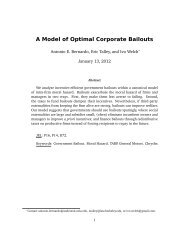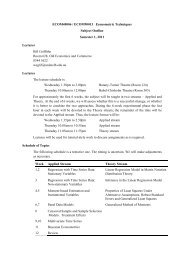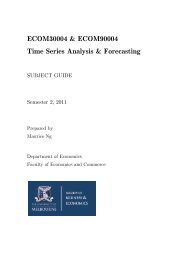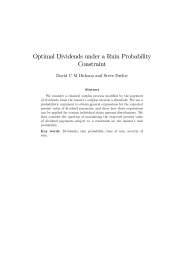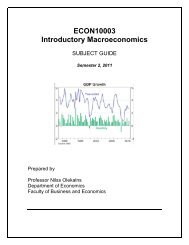Bayesian Inference in the Seemingly Unrelated Regressions Model
Bayesian Inference in the Seemingly Unrelated Regressions Model
Bayesian Inference in the Seemingly Unrelated Regressions Model
Create successful ePaper yourself
Turn your PDF publications into a flip-book with our unique Google optimized e-Paper software.
32<br />
⎛<br />
U U U<br />
y ⎞ ⎛<br />
() t X ⎞ ⎛<br />
() t e ⎞<br />
() t<br />
⎟=⎜ ⎟β +⎜ ⎜ O O O<br />
y ⎟ ⎜<br />
() t X ⎟ ⎜<br />
() t e ⎟<br />
⎝ ⎠ ⎝ ⎠ ⎝ () t ⎠<br />
(58)<br />
where we write<br />
⎡<br />
UU UO<br />
Σ Σ ⎤<br />
E⎡ ⎣<br />
e() t e()<br />
′<br />
t<br />
⎤<br />
⎦<br />
= ⎢ ⎥<br />
OU OO<br />
⎢⎣Σ<br />
Σ ⎥⎦<br />
(59)<br />
U<br />
t<br />
The conditional posterior pdf f( y() | βΣ , , y()<br />
) is a multivariate normal distribution<br />
with mean<br />
O<br />
t<br />
U O O UO OO−1<br />
O O<br />
() t () t () t () t () t<br />
E( y | β, Σ , y ) = X β +Σ Σ ( y −X<br />
β )<br />
(60)<br />
and covariance matrix<br />
U O UU UO OO−1<br />
OU<br />
() t y()<br />
t<br />
V( y | β, Σ , ) =Σ −Σ Σ Σ (61)<br />
U<br />
t<br />
O<br />
t<br />
Fur<strong>the</strong>rmore, ( y() | βΣ , , y()<br />
), t = 1 ,2,…,<br />
T are <strong>in</strong>dependent. Thus, for generat<strong>in</strong>g y()<br />
t<br />
with<strong>in</strong> <strong>the</strong> Gibbs sampler, we use <strong>the</strong> conditional normal distributions def<strong>in</strong>ed by<br />
equations (60) and (61) for all observations where an unobserved component is<br />
present.<br />
U<br />
Suppose, now, that <strong>the</strong> unobserved components represent negative values of a<br />
Tobit-type latent variable. In this case we have <strong>the</strong> additional posterior <strong>in</strong>formation<br />
U<br />
that <strong>the</strong> elements of y () t are negative. The conditional posterior pdf for<br />
U O<br />
() t y()<br />
t<br />
( y | βΣ , , ) becomes a truncated (multivariate) normal distribution with a<br />
U<br />
truncation that forces y () t to be negative. Its location vector and scale matrix (no<br />
longer <strong>the</strong> mean and covariance matrix) are given <strong>in</strong> equations (60) and (61). A



